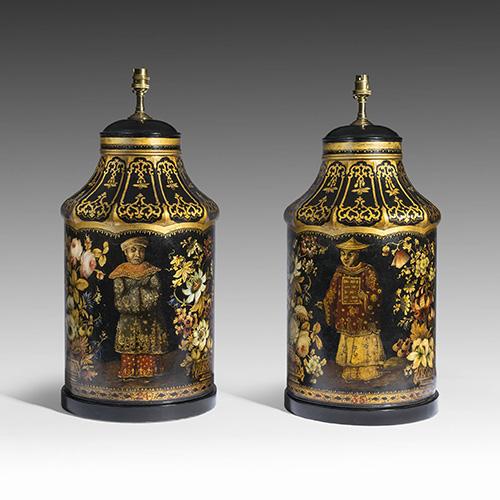

Tole or Toleware is a genre of painted or lacquered tin goods made popular throughout Europe and North America during the 18th century. The English term tole is taken directly from the French term tôle, which translates as sheet metal. The art of decorating toleware in French is known as tôle peinte, and is a term often used in the description of antique toleware items.
Production in the UK began in the South Wales town of Pontypool and was responsible for the rapid industrialisation of the area. John Hanbury (1664–1734), MP for Gloucester, inherited the local ironworks from his father in 1704 and began a period of expansion and innovation.
Hanbury utilised the knowledge of his agent Thomas Cooke, who had learned the process of tinplate production during a visit to Saxony, where it had been in production since the 1660s. The process involved coating sheets of wrought iron with a thin layer of tin, which renders the finished article rustproof.
 As a consequence, from 1706 onwards the Pontypool works were able to manufacture household items, in a durable hardwearing material, that could be quickly and easily cleaned for reuse. A wide variety of practical items were produced such as vases, trays, tea caddies, candlesticks, urns, teapots and ewers, all of which could be dropped, knocked, or mishandled with no fear of breaking or damage.
As a consequence, from 1706 onwards the Pontypool works were able to manufacture household items, in a durable hardwearing material, that could be quickly and easily cleaned for reuse. A wide variety of practical items were produced such as vases, trays, tea caddies, candlesticks, urns, teapots and ewers, all of which could be dropped, knocked, or mishandled with no fear of breaking or damage.
In a bid to enhance the appeal of the products, Thomas Allgood, manager of the Pontypool Ironworks, began experimenting with a decorative japanning process. This would allow products to be finished in the popular Japanese lacquer style that was all the rage in country houses of the Hanoverian era.
The process involved painting the finished toleware with decorative patterns before repeatedly lacquering to create a lasting finish. Unfortunately, Allgood passed away in 1716 before he was able to bring his vision into production. However, his sons Edward and Thomas brought his vision to life by opening their own works in the town and by early 1730 were producing vast quantities of Japanware decorated Tole.
In addition to supplying the British market, Welsh toleware was also much in demand in the North American colonies where local craftsmen were forbidden from producing their own products. As an added assurance, exports of tinplate to America were kept prohibitively expensive to discourage the risk of any local production.
 Despite competition from Paris and the Netherlands, South Wales had become the global heart of the tinware industry by the mid 18th century. Its dominance of the trade was enhanced by a family dispute following the passing of Edward Allgood in 1761, which would see a rival family toleware business open in the nearby town of Usk.
Despite competition from Paris and the Netherlands, South Wales had become the global heart of the tinware industry by the mid 18th century. Its dominance of the trade was enhanced by a family dispute following the passing of Edward Allgood in 1761, which would see a rival family toleware business open in the nearby town of Usk.
However, demand for the goods had declined by the early 19th century and both factories ceased production in the 1820s. By the mid 19th century, the toleware fashion was all but over and it would be 100 years before the style enjoyed a revival, sparked by French and Italian interior designers.
Click here to view a selection of toleware items currently available from BADA members.

